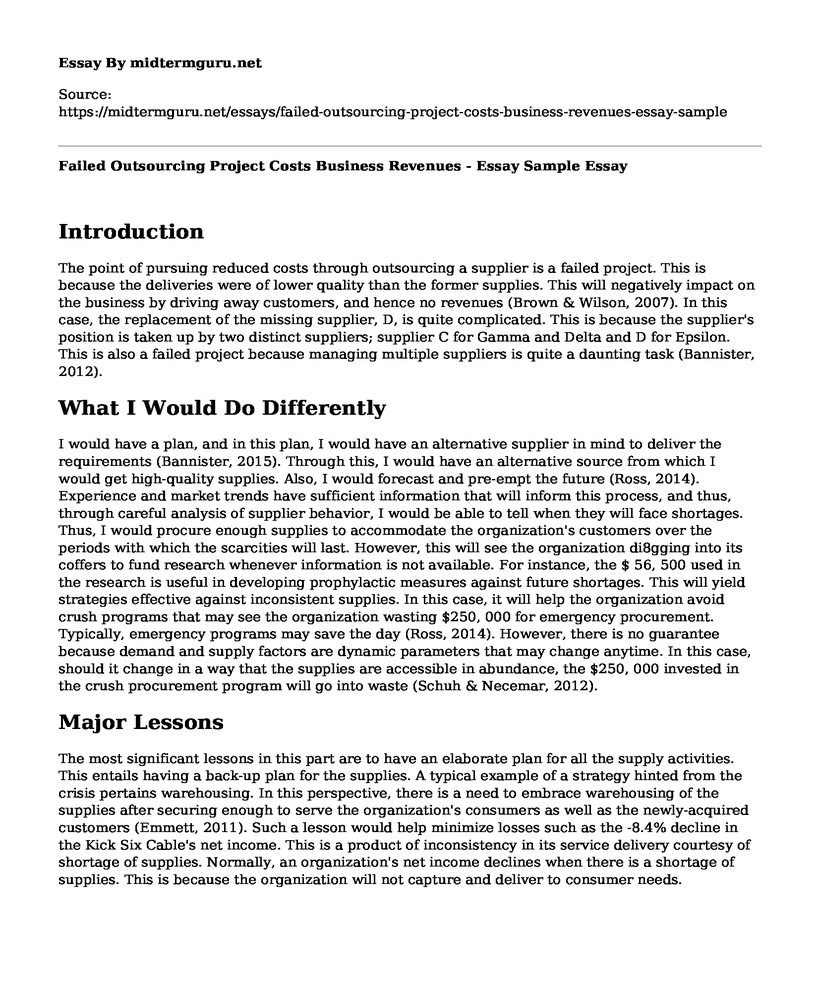Introduction
The point of pursuing reduced costs through outsourcing a supplier is a failed project. This is because the deliveries were of lower quality than the former supplies. This will negatively impact on the business by driving away customers, and hence no revenues (Brown & Wilson, 2007). In this case, the replacement of the missing supplier, D, is quite complicated. This is because the supplier's position is taken up by two distinct suppliers; supplier C for Gamma and Delta and D for Epsilon. This is also a failed project because managing multiple suppliers is quite a daunting task (Bannister, 2012).
What I Would Do Differently
I would have a plan, and in this plan, I would have an alternative supplier in mind to deliver the requirements (Bannister, 2015). Through this, I would have an alternative source from which I would get high-quality supplies. Also, I would forecast and pre-empt the future (Ross, 2014). Experience and market trends have sufficient information that will inform this process, and thus, through careful analysis of supplier behavior, I would be able to tell when they will face shortages. Thus, I would procure enough supplies to accommodate the organization's customers over the periods with which the scarcities will last. However, this will see the organization di8gging into its coffers to fund research whenever information is not available. For instance, the $ 56, 500 used in the research is useful in developing prophylactic measures against future shortages. This will yield strategies effective against inconsistent supplies. In this case, it will help the organization avoid crush programs that may see the organization wasting $250, 000 for emergency procurement. Typically, emergency programs may save the day (Ross, 2014). However, there is no guarantee because demand and supply factors are dynamic parameters that may change anytime. In this case, should it change in a way that the supplies are accessible in abundance, the $250, 000 invested in the crush procurement program will go into waste (Schuh & Necemar, 2012).
Major Lessons
The most significant lessons in this part are to have an elaborate plan for all the supply activities. This entails having a back-up plan for the supplies. A typical example of a strategy hinted from the crisis pertains warehousing. In this perspective, there is a need to embrace warehousing of the supplies after securing enough to serve the organization's consumers as well as the newly-acquired customers (Emmett, 2011). Such a lesson would help minimize losses such as the -8.4% decline in the Kick Six Cable's net income. This is a product of inconsistency in its service delivery courtesy of shortage of supplies. Normally, an organization's net income declines when there is a shortage of supplies. This is because the organization will not capture and deliver to consumer needs.
Significant Changes that I Would Consider
Communication
I would drastically change the communication mechanisms and procedures with the suppliers. This is an effective way of receiving information regarding looming events in the future (Mangan, Lalwani & Butcher, 2008). Normally, the suppliers would feel or sense a looming shortage of the products they deal in. Thus, keeping in touch with them in real-time is an effective way of learning about such issues. Therefore, I would recommend and ensure the establishment of a real-time communication process. This will enable the organization to detect future shortages as well as identify suppliers with the best quality. This communication structure will capture all the suppliers dealing in the products that the organization require in its operations.
Conclusion
There is a need for a rethinking of the supply chain links. This will restructure crucial activities that facilitate timely supplies for the organization. Through this, the organization will avoid unnecessary losses and costs. For instance, a decrease in income due to low-quality supplies.
References
Bannister, F. (2012). Purchasing and financial management of information technology. Routledge. Retrieved from https://books.google.co.ke/books?id=Bn4ABAAAQBAJ&pg=PA39&dq=disadvantage+of+having+many+different+suppliers&hl=en&sa=X&ved=0ahUKEwjKsZ60o-nhAhURhRoKHU55ADYQ6AEIKDAA#v=onepage&q=disadvantage%20of%20having%20many%20different%20suppliers&f=false
Brown, D., & Wilson, S. (2007). The black book of outsourcing: How to manage the changes, challenges, and opportunities. Hoboken, N, J: John Wiley & Sons. Retrieved from https://books.google.co.ke/books?id=gEwGRkZf7EYC&pg=PT331&dq=low+quality+and+low+pricing+in+outsourcing&hl=en&sa=X&ved=0ahUKEwinj5jwoOnhAhUGQBoKHczzCyAQ6AEILTAB#v=onepage&q=low%20quality%20and%20low%20pricing%20in%20outsourcing&f=false
Emmett, S. (2011). Excellence in warehouse management: How to minimise costs and maximise value. Chichester, West Sussex, England: Wiley. Retrieved from https://books.google.co.ke/books?id=9if0DXi4_IYC&printsec=frontcover&dq=the+need+for+warehousing&hl=en&sa=X&ved=0ahUKEwiW_eaCs-nhAhVC1xoKHUMXA1sQ6AEIKDAA#v=onepage&q=the%20need%20for%20warehousing&f=false
Mangan, J., Lalwani, C., & Butcher, T. (2008). Global logistics and supply chain management. Chichester, England: John Wiley & Sons. Retrieved from https://books.google.co.ke/books?id=9bpcxQIw484C&pg=PA214&dq=changes+necessary+in+supply+chain+management&hl=en&sa=X&ved=0ahUKEwj95ae4t-nhAhVFxYUKHXZEAxgQ6AEILjAB#v=onepage&q=changes%20necessary%20in%20supply%20chain%20management&f=false
Ross, D. F. (2014). Distribution Planning and Control: Managing in the Era of Supply Chain Management. Boston, MA: Springer US. Retrieved from https://books.google.co.ke/books?id=Z4LuBwAAQBAJ&printsec=frontcover&dq=planning+and++managing+supply+chain&hl=en&sa=X&ved=0ahUKEwi00ImZq-nhAhVSXhoKHXBHAXYQ6AEIKDAA#v=onepage&q=planning%20and%20%20managing%20supply%20chain&f=false
Schuh, C., & Necemar, T. (2012). The CPO: Transforming procurement in the real world. Berkeley, CA: Apress. Retrieved from https://books.google.co.ke/books?id=TiGXYLrtZdUC&printsec=frontcover&dq=the+dangers+of+emergency+procurement&hl=en&sa=X&ved=0ahUKEwjO6dr2tunhAhUCbBoKHQspDt4Q6AEIKDAA#v=onepage&q&f=false
Cite this page
Failed Outsourcing Project Costs Business Revenues - Essay Sample. (2023, Jan 08). Retrieved from https://midtermguru.com/essays/failed-outsourcing-project-costs-business-revenues-essay-sample
If you are the original author of this essay and no longer wish to have it published on the midtermguru.com website, please click below to request its removal:
- The Mazees Coffee Cafes Business Plan
- Accounts Payable Turnover Ratio for National Central Cooling Company
- Evaluation Paper on Nestle Inc and Unilever
- Essay Sample on Apple: Inclusion & Diversity-Open
- Research Paper on Theranos Scandal
- Essay Sample on Onboarding Processes and Strategies in a Company
- Improve Performance With DMAIC: A Six Sigma Process - Essay Sample







